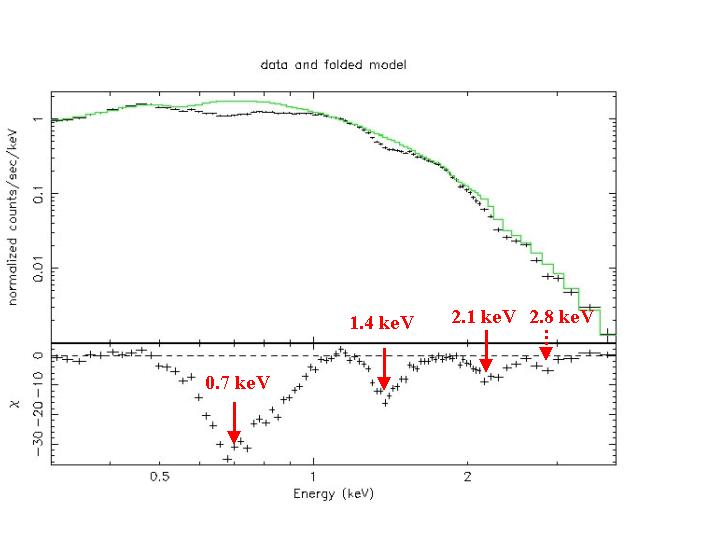1E1207 - XMM-Newton
Probing the Physics of a Neutron Star
Abstract
- Isolated neutron stars are highly magnetized, fast-rotating objects that form as an end point of stellar evolution. They are directly observable in X-ray emission because of their high surface temperatures. Features in their X-ray spectra could in principle reveal the presence of stellar atmospheres, or be used to estimate the strength of their magnetic fields through the cyclotron process, as is done for X-ray binaries. Almost all isolated neutron star spectra observed so far exhibit featureless thermal continua.
- The only exception is 1E1207.4-5209, where two deep absorption features have been detected, but with insufficient definition to permit unambiguous interpretation. The Nature paper reports a long X-ray observation of the same object, in which the star's spectrum shows three distinct features, regularly spaced at 0.7, 1.4 and 2.1 keV, plus a fourth feature of lower significance, at 2.8 keV. These features vary in phase with the star's rotation. The logical interpretation is that they are features from resonant cyclotron absorption, which allows the authors to calculate a magnetic field strength of 8E10 Gauss, assuming the absorption arises from electrons.
- Further information can be found in the following links:
Images
The neutron star 1E1207.4-5209 is seen as the bright yellow object in the centre of this image, which was taken with the European Photon Imaging Camera (EPIC) aboard ESA's X-ray observatory, XMM-Newton.
There are an estimated 100,000,000 neutron stars in the Galaxy. To date, only 1400 have been discovered via their radio emission and, of those, around 50 are known to emit X-rays.
1E 1207.4-5209 is the first isolated neutron star to show cyclotron absorption lines in its X-ray spectrum.
The data shown in the figure represent the longest observation performed so far on a galactic source by XMM-Newton.
Figure 2

This figure shows the X-ray spectrum of 1E1207.4-5209. The X-rays it emits clearly bear the "harmonic" marks, or are due to the resonant cyclotron absorption.
- Removed a total of (1) style text-align:center;
- Converted a total of (2) center to div.








































 Sign in
Sign in
 Science & Technology
Science & Technology